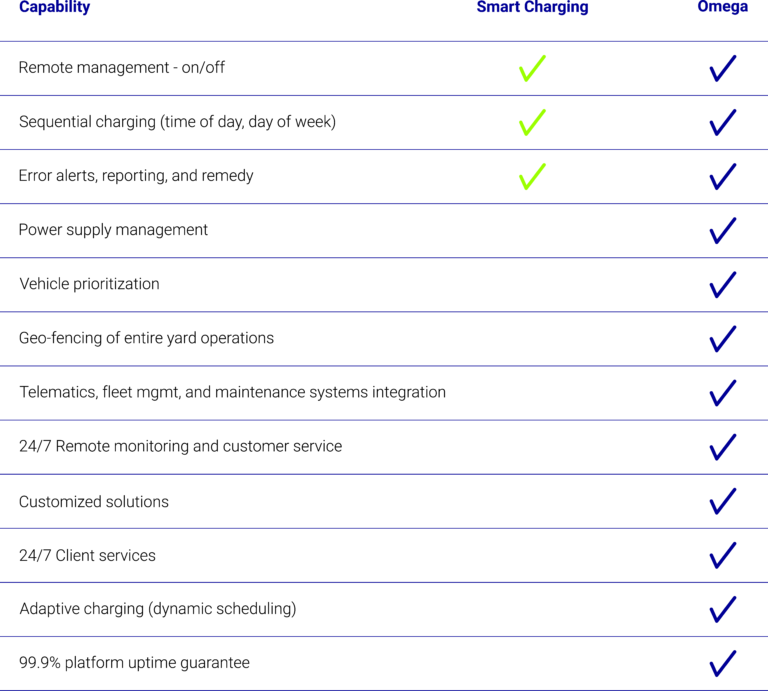managed charging
EV fleets 101: The benefits of managed charging
With the electrification movement well underway, fleets are introduced to a whole new glossary of terms and key considerations for selecting vehicle technology, charging infrastructure, and route optimization tools.
Once you have your electric vehicles (EVs) and charging infrastructure installed, you are now ready to get on the road. At this stage, fleet managers quickly realize that plugging in the vehicles and leaving them to charge with no management system–also known as unmanaged charging–can be an unruly and expensive endeavor. That’s where managed charging is a huge benefit to your operations.
What is smart charging?
When people hear the term ‘smart charging’, they’re often envisioning the capabilities that come with managed charging, but that’s not the case. Simply put, smart charging refers to the actual charger hardware for electric vehicles—the physical interface.
‘Smart’ charging simply means the charging technology has a wi-fi connection, enabling passive visibility to the data. This can provide high-level information such as the cost a fleet is paying for electricity, the amount of energy being pulled, or vehicles’ current state of charge. However, smart charging has limitations for fleets to act on that data. As a result, you must manually monitor and manage energy usage.
What is managed charging?
Managed charging uses cloud-based software that automatically adapts to fleet operations. This software allows remote charging session management, considering duty cycles, energy consumption, utility rates, demand responses, equipment faults, and more. Managed charging will automatically respond to this real-time data.
Benefits of managed charging
While managed charging certainly incorporates the simple functionality of smart charging, it goes far beyond those limitations to provide real value to fleets. Intelligent charge management systems (CMS), such as bp pulse Omega, feature cloud-based technology and onsite hardware that connects to the EV chargers, auxiliary meter, existing fleet telematics, and local utility.

Minimize electric utility costs
Managed charging, like Omega, automates charging during off-peak periods, when energy costs are lower, helping reduce electricity costs. The software navigates electricity costs that fluctuate on an hourly basis and schedules charging sessions to ensure vehicles are charged with lower-cost energy.
One of bp pulse’s Omega customers, Red Hook Terminals, is now charging at lower-cost energy times. In their first full quarter of using Omega, Red Hook’s fleet reduced demand charges by 55% in peak months.
Maximize vehicle uptime
With charge management software, fleet managers get complete visibility of EV charging operations and receive real-time alerts all from one dashboard. This means you can spot and react to any potential problems fast, maximizing vehicle uptime.
For bp pulse Omega customer, Red Hook Terminals, they now have visibility into each vehicle’s state of charge, can schedule charging based on duty cycles, and track current and maximum energy capacity at the site. With this tool, Red Hook improved fleet readiness, starting 95% of their EV trips with a 99% state of charge.
Integrate with your fleet telematics
Omega is technology agnostic, meaning it can integrate with any EV, charger, telematics, or fleet management tool. You gain the benefits of managed charging without changing existing infrastructure and can easily add new technology in future.
As fleets convert to EVs over time, they may need to deploy a mix of technologies from various vendors, so we designed Omega to work with what you have, or what you will have.
Safeguard against power failures: Automated load management
With bp pulse Omega, the software includes a site controller, located at your charging facilities. This site controller uses automated load management to ensure your power draw does not exceed the capacity of your transformer or chargers, helping to avoid service disruption. Learn more about automated load management.
As fleets embrace electrification, the adoption of managed charging systems like bp pulse Omega emerges as a critical strategy. Beyond the basic functionalities of smart charging, managed charging offers comprehensive benefits. These advancements not only streamline operations but also enhance efficiency and cost-effectiveness, positioning managed charging as a significant tool for fleets.

Learn more about Omega charge management software
Our cloud-based charge management software, Omega, provides tools for an EV fleet operator to ensure vehicles are not only charged but charged at lower-cost energy times.
Date
21 July 2024
author

Meg Dinga
Head of EV Program Integration
bp pulse fleet
Topics


